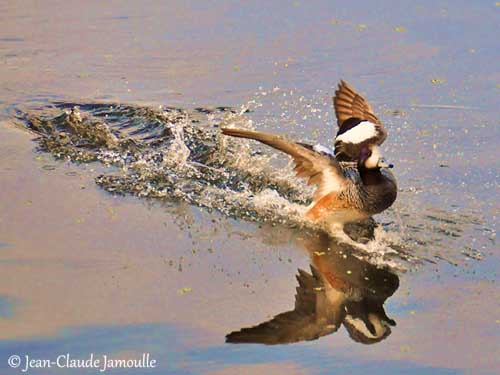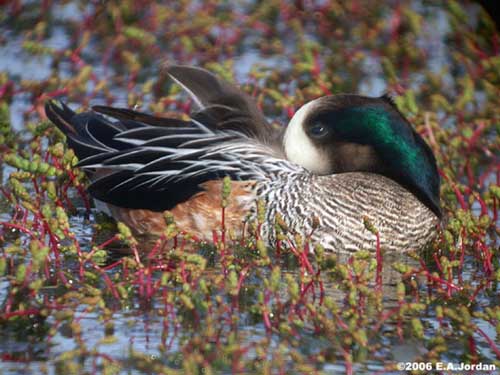
Fr: Canard de Chiloé
All: Chilepfeifente
Esp: Pato ovejero, Pato Overo, Pato real, Silbón overo
Ital: Fischione del Cile
Nd: Chileense Smient
Sd: Chilensk bläsand
Photographers:
Jean-Claude Jamoulle
A la rencontre des Oiseaux
Eduardo Andrés Jordan
MIS AVES – AVES DE ARGENTINA
Otto Plantema
Trips around the world
Text by Nicole Bouglouan
Sources:
HANDBOOK OF THE BIRDS OF THE WORLD vol 1 by Josep del Hoyo-Andrew Elliot-Jordi Sargatal - Lynx Edicions - ISBN: 8487334105
GUIDE DES CANARDS, DES OIES ET DES CYGNES – de Steve Madge - Delachaux et Niestlé - ISBN: 2603013769
BirdLife International (BirdLife International)
ANIMALS – Explore, discover, connect
Chiloe Wigeon
Mareca sibilatrix
Anseriformes Order – Anatidae Family
INTRODUCTION:
The Chiloe Wigeon is a Chilean whistling duck. Its name comes from the Chiloe Islands, off the Chilean coasts. It is also found around the Falklands. This species is gregarious and sociable.
DESCRIPTION OF THE BIRD:
Biometrics:
Length: 43-54 cm
Wingspan: 75-86 cm
Weight: M: 940 g – F: 830 g
The adult male has black upperparts with white-edged feathers (including the long scapulars and tertials). On the upperwing, the primaries are dark grey-brown, the secondaries are black with green gloss, and the upperwing-coverts are white, forming a conspicuous mirror well visible in flight. The greater covert’s tips are black. The rump and the uppertail-coverts are white. The tail is black.
On the underparts, the breast is finely barred black-and-white. The flanks are buff. Belly and vent are buffish. The undertail-coverts are pale buff. The underwing is greyish-white.

The head is black on crown and nape, and on throat and neck. Head sides are glossy green, from the eyes to the nape, and the face is white, including forehead, lores and cheeks. We can see a white cheek patch.
The bill is blue-grey with black tip. The eyes are dark brown. Legs and webbed feet are dark grey.
Both sexes are similar but the female is duller.
We can find two morphs in each sex, one with sharp colours and bright reddish flanks, and the other duller, with washed reddish and brown plumage, and paler flanks.
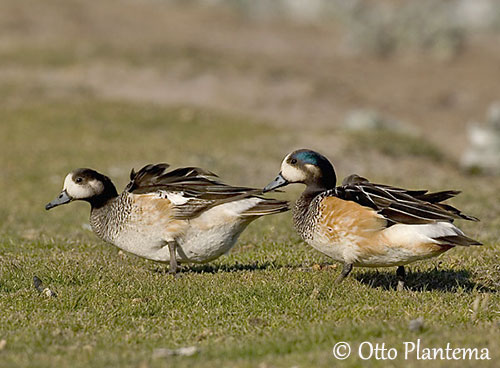
The juvenile is duller, with blackish head but without any gloss or white sharp patch on the cheek. The upperwing-coverts are spotted brownish.
The juvenile in dull morph has brownish flanks and upperparts, and the face is whitish. But it is mostly bleached overall.
The chicks are dark brown above, whereas underparts, wing and back pattern are buff. Head sides are buff with black eye stripe.
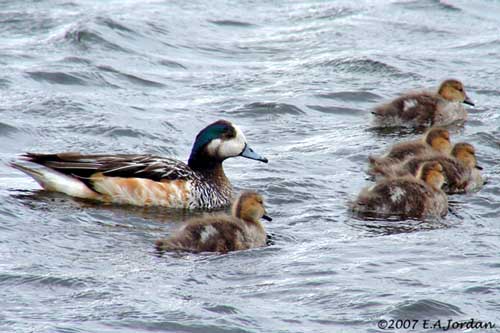
RANGE:
The Chiloe Wigeon is found in South America, S of C Argentina and C Chile. It is also visible on Falkland Islands and reported too on South Georgia and Orkney Islands. Escaped birds occur in Europe and North America.
HABITAT:
The Chiloe Wigeon frequents freshwater lakes and lagoons, slow-flowing rivers where it can find vegetation, and occurs in areas with scattered trees, creeks and zones with algae where it can feed.
CALLS AND SONGS: SOUNDS BY XENO-CANTO
The Chiloe Wigeon is more vocal during the courtship displays. The male gives shrill whistles “ouir ouir ouuiberrr” when flying or from water. The female has lower voice and utters some grunts “ar arr”.
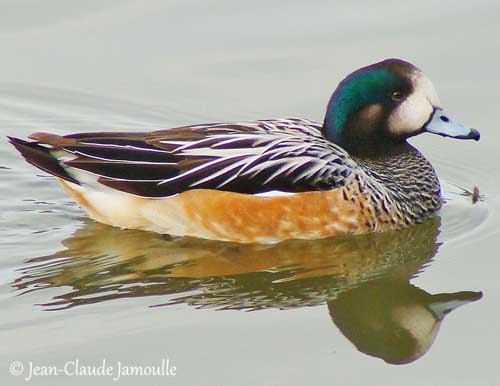
BEHAVIOUR IN THE WILD:
The Chiloe Wigeon feeds by grazing in dry areas, but also by dabbling, head-dipping or upending repeatedly, to reach its aquatic food. Like other Anatidae, it puts the head underwater in order to find aquatic plants and other small preys. Its short bill is well adapted, allowing it to cut its favourite grasses, sedges and greener parts of aquatic vegetation. However, it may also take worms, larvae and fish during the summer.
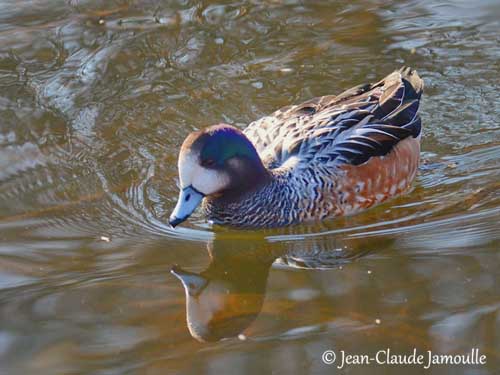
It is difficult to approach this duck. It swims towards the middle of the lake or the lagoon, or takes off to the opposite shore to go away from intruders.
It is usually gregarious but it becomes territorial during the breeding season. Outside this period, they feed in small groups. But after the nesting season, when they are moulting, some lakes may have up to 5000 ducks in January and February.
The Chiloe Wigeon appears to live in pair all year round, but the pair-bonds between mates are not necessarily permanent. A new pair forms some time after the reproduction.
During the courtship displays, male and female perform mutual preening in order to strengthen the pair-bonds. Another display shows the male swimming ahead of the female and turning regularly the head towards her.
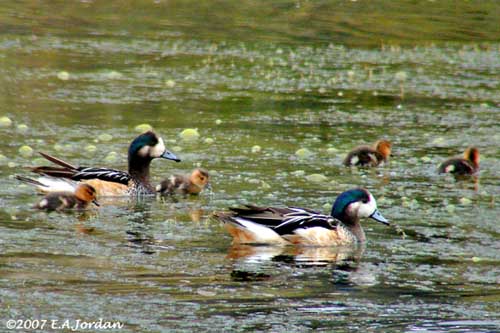
The southern populations migrate to Uruguay, Paraguay and S Brazil, whereas the Falkland population is sedentary. This duck does not migrate very far, and only travels to find water and food resources.
The Chiloe Wigeon flies easily and moves to other areas for more suitable locations and food sources.
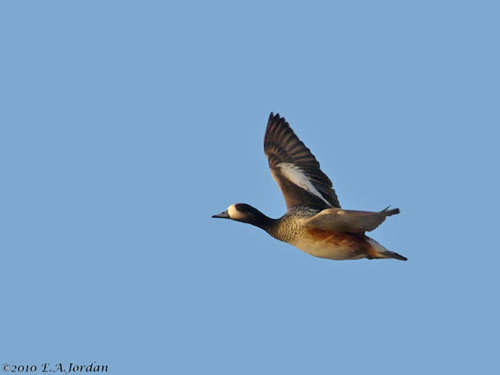
REPRODUCTION OF THIS SPECIES:
The Chiloe Wigeon starts to breed in August/September, to December. It breeds in isolated pair or in loose groups, in dry area. The female establishes the nest-site in tall grasses or under bushes. It is a shallow depression on the ground, hidden among the vegetation, at some distance from the water. The nest is made with grass and lined with small feathers.
The female lays 5-8 white to pale buff eggs. She incubates during 24-26 days, while the male remains in the vicinity of the nest and watches around. It takes part in nesting duties as soon as the chicks hatch. They leave the nest very soon after hatching, and are able to feed themselves with small invertebrates, accompanied by their parents. They fledge about 45-55 days after hatching.
The male may raise them alone if the female dies. The pair may have strong pair-bonds, sometimes for life.
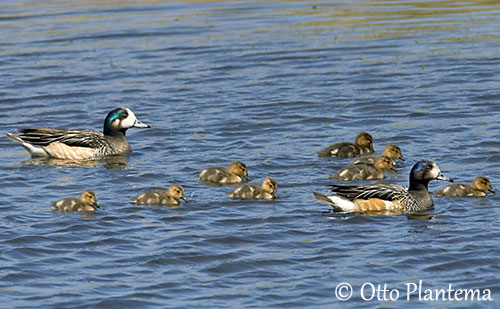
PROTECTION / THREATS / STATUS:
The Chiloe Wigeon is widespread in spite of natural predators such as mammals and birds of prey, hunting pressure and habitat destruction.
This species is not currently threatened.
